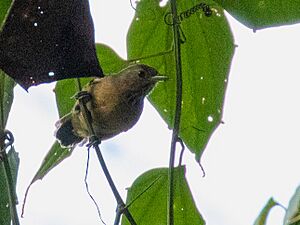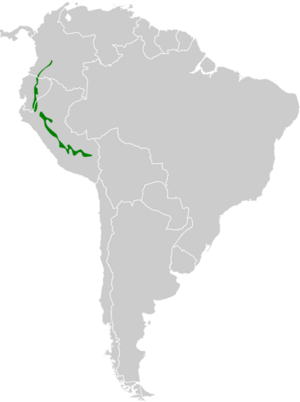Foothill stipplethroat facts for kids
Quick facts for kids Foothill stipplethroat |
|
|---|---|
 |
|
| Conservation status | |
| Scientific classification | |
| Genus: |
Epinecrophylla
|
| Species: |
spodionota
|
| Subspecies | |
|
See text |
|
 |
|
| Synonyms | |
|
Myrmotherula spodionota |
|
The foothill stipplethroat (Epinecrophylla spodionota) is a small bird. It belongs to the "typical antbirds" family. You can find it in Colombia, Ecuador, and Peru. This bird used to be called the "foothill antwren".
Contents
About Its Name: Taxonomy
This bird was first described in 1880. Two English bird experts, Philip Sclater and Osbert Salvin, gave it its original scientific name. Later, scientists studied its genes and calls. They found it was different from other birds in its old group. So, it was moved to a new group called Epinecrophylla.
All birds in this new group are now called "stipplethroats". This name highlights a special feature they share. It also helps tell them apart from other antwrens.
Subspecies of the Foothill Stipplethroat
The foothill stipplethroat has two types, called subspecies.
- E. s. spodionota was named by Sclater and Salvin in 1880.
- E. s. sororia was named by von Berlepsch and Stolzmann in 1894.
What It Looks Like: Description
The foothill stipplethroat is a small bird. It is about 10 to 11 cm (4 to 4.3 in) long. It weighs about 9 to 10.5 grams (0.32 to 0.37 oz).
Male Foothill Stipplethroat
Adult males of the main subspecies have a gray face. Their throat is black with white spots. Their head and back are dark gray with a brown tint. Their lower back is a dark reddish yellow-brown. Their tail and flight feathers are dark brown. The feathers covering their wings are blackish brown. These feathers have pale buff or white tips. Their chest and upper belly are gray. Their lower belly and sides are reddish yellow-brown.
Males of the E. s. sororia subspecies look a bit different. Their upper parts are more olive. They have less reddish color on their lower back and sides.
Female Foothill Stipplethroat
Adult females have a yellow-ochre face, throat, and underparts. Their throat might have some darker spots. Their upper parts are olive-brown. Their lower back has a buff tint. Their wings and flight feathers are brown. The feathers covering their wings are brown with pinkish buff tips.
Females of the E. s. sororia subspecies have paler underparts than the main subspecies.
Where It Lives: Distribution and Habitat
The main subspecies of the foothill stipplethroat lives on the east side of the Andes mountains. You can find it from southern Colombia, through Ecuador, and into northern Peru. It goes as far south as the Marañón River.
The E. s. sororia subspecies lives in Peru. It is found south of the Marañón River. Its range extends as far as the Department of Madre de Dios.
This bird lives in the lower parts of foothill forests. These are evergreen forests in the mountains. In Colombia, it lives between 600 and 1,400 meters (2,000 and 4,600 ft) high. In Ecuador, it lives between 600 and 1,425 meters (2,000 and 4,675 ft) high. In Peru, it can be found as low as 500 meters (1,600 ft).
How It Behaves: Behavior
Movement and Migration
The foothill stipplethroat stays in the same area all year. It does not migrate.
What It Eats: Feeding Habits
This bird eats arthropods. These are small creatures like insects and probably spiders. It usually looks for food alone or in pairs. Sometimes, small family groups forage together. They often join groups of different bird species that are also looking for food.
The stipplethroat mostly searches for food in the forest understory. This is up to about 4 meters (13 ft) above the ground. Sometimes, it goes as high as 8 meters (26 ft). It finds its prey by picking it off dead leaves. These leaves can be on trees or caught in vines and small palm plants. It less often feeds from moss, tree bark, or live leaves.
Life Cycle: Reproduction
We do not know much about the foothill stipplethroat's breeding season. We know it includes the month of March. More studies are needed to learn about its breeding habits.
What It Sounds Like: Vocalization
The foothill stipplethroat's song is a trill. It has short, high-pitched notes. The song starts by going up sharply in pitch. Then, it slowly drops in pitch. Its calls include a short, high-pitched rattling sound.
Its Future: Status
The IUCN (International Union for Conservation of Nature) has looked at the foothill stipplethroat. They say it is a species of "Least Concern". This means it is not currently at high risk of disappearing.
The bird lives in a very large area. We do not know its exact population size. However, experts believe its numbers are going down. No immediate big threats have been found. It is considered uncommon to fairly common where it lives.
This bird lives in some protected areas. But the lower parts of the Andes mountains are at risk. These areas are losing forests due to people clearing land for farming. This is a concern for the foothill stipplethroat.


